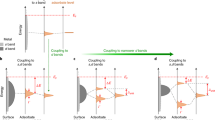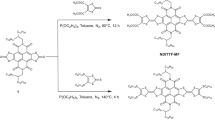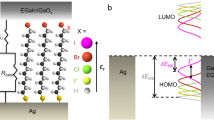Abstract
Charge transport across metal–molecule interfaces has an important role in organic electronics1. Typically, chemical link groups such as thiols2 or amines3 are used to bind organic molecules to metal electrodes in single-molecule circuits, with these groups controlling both the physical structure and the electronic coupling at the interface. Direct metal–carbon coupling has been shown through C60, benzene and π-stacked benzene4,5,6,7, but ideally the carbon backbone of the molecule should be covalently bonded to the electrode without intervening link groups. Here, we demonstrate a method to create junctions with such contacts. Trimethyl tin (SnMe3)-terminated polymethylene chains are used to form single-molecule junctions with a break-junction technique2,3. Gold atoms at the electrode displace the SnMe3 linkers, leading to the formation of direct Au–C bonded single-molecule junctions with a conductance that is ∼100 times larger than analogous alkanes with most other terminations. The conductance of these Au–C bonded alkanes decreases exponentially with molecular length, with a decay constant of 0.97 per methylene, consistent with a non-resonant transport mechanism. Control experiments and ab initio calculations show that high conductances are achieved because a covalent Au–C sigma (σ) bond is formed. This offers a new method for making reproducible and highly conducting metal–organic contacts.
This is a preview of subscription content, access via your institution
Access options
Subscribe to this journal
Receive 12 print issues and online access
$259.00 per year
only $21.58 per issue
Buy this article
- Purchase on Springer Link
- Instant access to full article PDF
Prices may be subject to local taxes which are calculated during checkout



Similar content being viewed by others
References
Nitzan, A. & Ratner, M. A. Electron transport in molecular wire junctions. Science 300, 1384–1389 (2003).
Xu, B. Q. & Tao, N. J. Measurement of single-molecule resistance by repeated formation of molecular junctions. Science 301, 1221–1223 (2003).
Venkataraman, L. et al. Single-molecule circuits with well-defined molecular conductance. Nano Lett. 6, 458–462 (2006).
Kiguchi, M. et al. Highly conductive molecular junctions based on direct binding of benzene to platinum electrodes. Phys. Rev. Lett. 101, 046801 (2008).
Kaneko, S., Nakazumi, T. & Kiguchi, M. Fabrication of a well-defined single benzene molecule junction using Ag electrodes. J. Phys. Chem. Lett. 1, 3520–3523 (2010).
Schneebeli, S. T. et al. Single-molecule conductance through multiple π−π-stacked benzene rings determined with direct electrode-to-benzene ring connections. J. Am. Chem. Soc. 133, 2136–2139 (2011).
Martin, C. A. et al. Fullerene-based anchoring groups for molecular electronics. J. Am. Chem. Soc. 130, 13198–13199 (2008).
Millar, D., Venkataraman, L. & Doerrer, L. H. Efficacy of Au–Au contacts for scanning tunneling microscopy molecular conductance measurements. J. Phys. Chem. C 111, 17635–17639 (2007).
Bulten, E. J. & Budding, H. A. Synthesis of small-ring monostannacycloalkanes. J. Organomet. Chem. 110, 167–174 (1976).
Kamenetska, M. et al. Formation and evolution of single-molecule junctions. Phys. Rev. Lett. 102, 126803 (2009).
Hines, T. et al. Transition from tunneling to hopping in single molecular junctions by measuring length and temperature dependence. J. Am. Chem. Soc. 132, 11658–11664 (2010).
Hybertsen, M. S. et al. Amine-linked single-molecule circuits: systematic trends across molecular families. J. Phys. Condens. Matter 20, 374115 (2008).
Li, C. et al. Charge transport in single Au vertical bar alkanedithiol vertical bar Au junctions: coordination geometries and conformational degrees of freedom. J. Am. Chem. Soc. 130, 318–326 (2008).
Akkerman, H. B. & de Boer, B. Electrical conduction through single molecules and self-assembled monolayers. J. Phys. Condens. Matter 20, 013001 (2008).
Park, Y. S. et al. Contact chemistry and single-molecule conductance: a comparison of phosphines, methyl sulfides, and amines. J. Am. Chem. Soc. 129, 15768–15769 (2007).
Tomfohr, J. K. & Sankey, O. F. Complex band structure, decay lengths, and Fermi level alignment in simple molecular electronic systems. Phys. Rev. B 65, 245105 (2002).
Bennett, M. A., Bhargava, S. K., Hockless, D. C. R., Welling, L. L. & Willis, A. C. Dinuclear cycloaurated complexes containing bridging (2-diphenylphosphino)phenylphosphine and (2-diethylphosphino)phenylphosphine, C6H4PR2 (R=Ph, Et). Carbon–carbon bond formation by reductive elimination at a gold(II)−gold(II) center. J. Am. Chem. Soc. 118, 10469–10478 (1996).
Yanson, A. I., Bollinger, G. R., van den Brom, H. E., Agrait, N. & van Ruitenbeek, J. M. Formation and manipulation of a metallic wire of single gold atoms. Nature 395, 783–785 (1998).
Porter, K. A., Schier, A. & Schmidbaur, H. in Perspectives in Organometallic Chemistry (eds Steele, B. R. & Screttas, C. G.) 74–85 (Royal Society of Chemistry, 2003).
Parameswaran, R. et al. Reliable formation of single molecule junctions with air-stable diphenylphosphine linkers. J. Phys. Chem. Lett. 1, 2114–2119 (2010).
Guohui, M. et al. Low-bias conductance of single benzene molecules contacted by direct Au–C and Pt–C bonds. Nanotechnology 21, 495202 (2010).
Perdew, J. P., Burke, K. & Ernzerhof, M. Generalized gradient approximation made simple. Phys. Rev. Lett. 77, 3865–3868 (1996).
Jaguar v7.5 (Schrodinger LLC, 2008).
Soler, J. M. et al. The SIESTA method for ab initio order-N materials simulation. J. Phys. Condens. Matter 14, 2745–2779 (2002).
Brandbyge, M., Mozos, J. L., Ordejon, P., Taylor, J. & Stokbro, K. Density-functional method for nonequilibrium electron transport. Phys. Rev. B 65, 165401 (2002).
Koentopp, M., Burke, K. & Evers, F. Zero-bias molecular electronics: exchange-correlation corrections to Landauer's formula. Phys. Rev. B 73, 121403 (2006).
Thygesen, K. S. & Rubio, A. Renormalization of molecular quasiparticle levels at metal–molecule interfaces: trends across binding regimes. Phys. Rev. Lett. 102, 046802 (2009).
Delaney, P. & Greer, J. C. Correlated electron transport in molecular electronics. Phys. Rev. Lett. 93, 036805 (2004).
Neaton, J. B., Hybertsen, M. S. & Louie, S. G. Renormalization of molecular electronic levels at metal–molecule interfaces. Phys. Rev. Lett. 97, 216405 (2006).
Quek, S. Y. et al. Amine–gold linked single-molecule circuits: experiment and theory. Nano Lett. 7, 3477–3482 (2007).
Ma, G. H. et al. Low-bias conductance of single benzene molecules contacted by direct Au–C and Pt–C bonds. Nanotechnology 21, 495202 (2010).
Acknowledgements
This work was supported primarily by the Nanoscale Science and Engineering Initiative of the National Science Foundation (NSF; CHE-0641523), the New York State Office of Science, Technology, and Academic Research (NYSTAR) and an NSF Career Award to L.V. (CHE-07-44185). This work was carried out in part at the Center for Functional Nanomaterials, Brookhaven National Laboratory, which is supported by the Office of Basic Energy Sciences of the US Department of Energy (DOE; DE-AC02-98CH10886). This work was also supported in part by the DOE Energy Frontier Research Centers programme (EFRC; DE-SC0001085).
Author information
Authors and Affiliations
Contributions
Z.L.C., R.S., S.S. and W.C. synthesized the compounds. J.R.W. performed the experiments and data analysis. H.V. carried out all calculations. M.S.H., R.B. and L.V. conceived and designed the experiments and calculations, and co-wrote the paper.
Corresponding authors
Ethics declarations
Competing interests
The authors declare no competing financial interests.
Supplementary information
Supplementary information
Supplementary information (PDF 734 kb)
Rights and permissions
About this article
Cite this article
Cheng, ZL., Skouta, R., Vazquez, H. et al. In situ formation of highly conducting covalent Au–C contacts for single-molecule junctions. Nature Nanotech 6, 353–357 (2011). https://doi.org/10.1038/nnano.2011.66
Received:
Accepted:
Published:
Issue Date:
DOI: https://doi.org/10.1038/nnano.2011.66
This article is cited by
-
Cleavage of non-polar C(sp2)‒C(sp2) bonds in cycloparaphenylenes via electric field-catalyzed electrophilic aromatic substitution
Nature Communications (2023)
-
Reactions in single-molecule junctions
Nature Reviews Materials (2022)
-
σ–σ Stacked supramolecular junctions
Nature Chemistry (2022)
-
A single-molecule blueprint for synthesis
Nature Reviews Chemistry (2021)
-
Chimeric vaccine designs against Acinetobacter baumannii using pan genome and reverse vaccinology approaches
Scientific Reports (2021)



